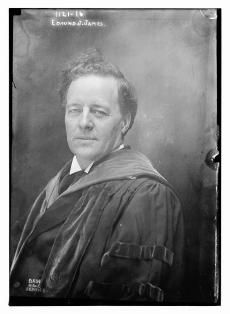Celebrating 135 Years
On the morning of December 14, 1889, twenty-two people met in Philadelphia to form the American Academy of Political and Social Science.
Above: This brief history of the Academy was compiled for its 125th anniversary in 2015.

Edmund J. James
Founding president (1890–1901)
Presidents of the Academy
- Marta Tienda (2021–present)
- Kenneth Prewitt (2015–2021)
- Douglas S. Massey (2006–2015)
- Lawrence W. Sherman (2001–2005)
- Jaroslav Pelikan (1999–2001)
- Kathleen Hall Jamieson (1998–1999)
- Marvin E. Wolfgang (1972–1998)
- Richard D. Lambert (1970–1972)
- James C. Charlesworth (1953–1970)
- Ernest M. Patterson (1930–1953)
- Leo S. Rowe (1902–1930)
- Samuel M. Lindsay (1901–1902)
- Edmund J. James (1890–1901)
Led by Edmund James, the group created a forum to synthesize and advance research on contemporary political, economic, social, and policy issues. Unlike most organizations at the time, the Academy embraced a broad array of social science disciplines while concurrently serving as a forum for scientific thought and practical policy discussion. The goal was timely: the late 19th century witnessed an explosion of specialization and professionalization in the social sciences, a trend that threatened to splinter America’s understanding of major policy issues. The Academy wanted to rectify this problem by bringing in specialized and professionalized experts to voice and confront the problems collectively.
The Academy’s founders created a democratic institutional system to ensure both the success and transparency of the organization. Past Academy leaders have included Woodrow Wilson (vice president 1895–1905) and Herbert Hoover (vice president 1921–1964), as well as college deans, former senators, philanthropists, businesspeople, and university presidents.
Launched a year after the Academy’s founding, The ANNALS served as a bimonthly outlet for the Academy’s scholarship. From its inception, each iteration of the journal has tackled a single topic: past volumes have covered foreign policy in Japan, child labor, contemporary race relations in America, and much more. Similar to the Academy, The ANNALS was established with the goal of embracing both practical and theoretical work and disseminating this research across the country—and even around the world.
Over the years, the Academy supplemented The ANNALS with pamphlets, monographs and, most notably, annual meetings about our volumes’ topics. Such meetings historically drew crowds that numbered over 1,000 and garnered widespread coverage from periodicals such as The New York Times, The Philadelphia Inquirer, and the Chicago Tribune. Ambassadors, government officials, politicians, university scholars, and scientific and business organizations all attended the meetings, which covered a variety of topics over the years. Paper readings and important policy speeches by notable figures—such as then-Vice President Richard Nixon—headlined these meetings.
Since the turn of the millennium, the Academy has revamped many of its proceedings to adapt to new advances in communication, research, and technology. As older membership models became outdated, the Academy began to regularly sponsor or cosponsor events to share the research of The ANNALS with the wider AAPSS community and beyond. Such events have included a panel on working-class families hosted by C-SPAN, a discussion on terrorism in the Trump administration, and a series of webinars on democratic vulnerability.
Amidst these adaptations and changes, the Academy has continued to recognize leaders in the social and political sciences through its annual programming. In 2000, the Academy began inducting a select few leading scholars and public intellectuals each year as Fellows. The Daniel Patrick Moynihan Prize was established in 2008 to recognize individuals who, like the late senator and Academy fellow, have dedicated their careers to advancing social science scholarship in the public sphere.
As the Academy moves further into its second century, it seeks to uphold the ideals of its founders through modern means: social media, conferences, webinars, and more. Articles from The ANNALS dating back to 1890 have been digitized and are available through Sage Publications, and new scholarship has pushed the Academy in directions far beyond what its founders could have ever imagined.
While today’s Academy might seem nearly unrecognizable to its founding members, its mission has remained much the same—to recognize scholarly excellence that promotes the advancement and dissemination of practical and theoretical inquiries.
The American Academy of Political and Social Science
PO Box 30732
Philadelphia, PA 19104
(215) 746-6500
